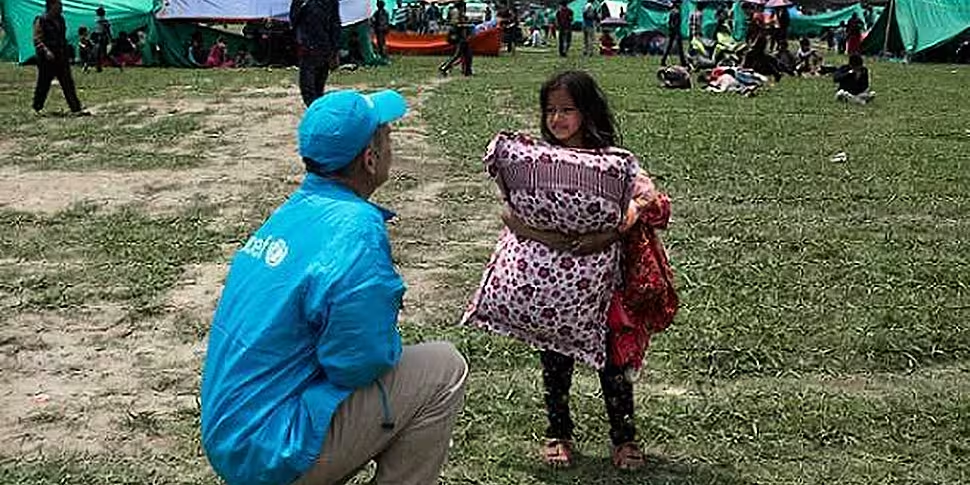Authorities in Nepal say they're 'overwhelmed' after Saturday's earthquake, which is known to have killed more than 4,000 people and left at least 6.538 people injured.
Aid is starting to arrive there, and around 120 Irish people are understood to be caught up in the quake.
The Red Cross has compiled a list of Irish people who are understood to be in the country, but have not been heard from since the quake.
Nepal Earthquake - ICRC register of missing persons https://t.co/vX9HZkdIH8 via @sharethis #NepalEarthquake
— Irish Red Cross (@irishredcross) April 26, 2015
The head of International Programmes at the Irish Red Cross, John Roche, says the online register is for family here, and for anyone in Nepal:
Ireland is providing €1 million in aid to help families hit by the devastating earthquake.
The Minister for Foreign Affairs Charlie Flanagan says Ireland will help to provide food, water and shelter to displaced families.
"We are aware that hundreds of thousand are now currently sleeping in the open too frightened to return to their homes due to the dozens of aftershocks, including a 6.7 magnitude tremor which occurred yesterday," he explained.
Drone footage has shown the level of destruction across the capital Kathmandu following the earthquake:
The images show toppled monuments, cracks across major roads and widespread damage to residential buildings across the city.
Thousands of people in Kathmandu spent the night huddled under tents and sought scarce food and medical supplies as officials struggled to care for the injured and homeless.
Many were unable to find beds in the devastated city's hospitals, with surgeons setting up an operating theatre inside a tent in the grounds of Kathmandu Medical College.
"We are overwhelmed with rescue and assistance requests from all across the country," said Deepak Panda, a member of the country's disaster management.
Mass cremations are continuing in the capital, where people queued for water dispensed from the back of trucks and those shops still open had next to nothing on their shelves.
Efforts to dig victims out from under the rubble are continuing and rescue missions are arriving in the region to help cope with the aftermath of the earthquake.
The Department of Foreign Affairs says contact is being made with many of the Irish people affected, but is warning that it is taking time due to the impact on the communications network in the region.
GOAL has dispatched an emergency response team to Nepal to support relief efforts.
"We have spoken with local agencies on the ground who have confirmed that hospitals are overrun and that huge numbers of people have been left homeless and are sleeping rough," said GOAL CEO, Barry Andrews.
"Recovery teams are continuing to search desperately for survivors trapped in the rubble, a task that has been compounded by the fact that the entire city is without electricity."
"We have also received reports that a large number of villages on the outskirts of the capital have been completely flattened. Unfortunately, we are expecting the numbers of dead and injured to rise significantly in the coming hours."
One Irish woman caught up in the disaster is Catherine Jordan from Co Wexford. She is among a group of eight that had travelled to the region.
Her son, Keith Jordan, told Newstalk Breakfast why his mother is there - and how she is doing.
Jack Horgan is communications director with the Umbrella Foundation. He told Newstalk Breakfast that children are especially vulnerable now.
While one worker in Nepal, World Vision communications officer Matt Darvas, has told of seeing babies born in the open.
"Outside in the fields surrounding the hospital were hundreds of patients who were in the hospital when the earthquake hit. They are afraid to go inside with aftershocks continuing. Several women gave birth in the sun outside on the grass lying on nothing more than 'yoga mats'".
"I saw one baby born in front of me, an incredible testimony to the power of life amidst so much death and chaos," Darvas said, at Western Regional Hospital, Pokhara hospital, six hours walk from the quake's epicentre.
At the hospital, survivor Dhan Bahadur Gale (75), who's village is close to the epicentre of the quake, said that 90% of the 1,100 homes in his village are decimated.
"Standing outside my home at the time, when I finally looked up, only a few walls remained. I have no idea how many people survived the quake or what conditions my fellow villagers are facing but I fear the worst."
"When the earthquake struck it was like a volcano had erupted".
Climbers remain trapped
Meanwhile, hundreds of foreign and Nepalese climbers remained trapped in the Himalayas after a huge avalanche triggered by the quake ripped through a base camp for climbers.
Footage has emerged of the moment the avalanche hit, sending mountaineers scrambling for cover and killing 18 people.
Up to 70% of houses in rural areas have reportedly been destroyed close to the 7.8-magnitude earthquake's epicentre in Gorkha.
It is Nepal's most deadly disaster of its kind since 1934, when 8,500 died. Another 66 were killed across the border in India, and at least another 20 in Tibet.
Several countries rushed to send aid and rescue workers. India flew in medical supplies and members of its National Disaster Response Force and China sent a 60-strong emergency team.
Britain, which believes several hundred of its nationals are in Nepal, said it was delivering supplies, medics and search-and-rescue teams.
Pakistan's army said it was sending four C-130 aircraft with a 30-bed hospital, search and rescue teams and relief supplies.
A Pentagon spokesman said a US military aircraft with 70 personnel was due in Kathmandu on Monday and Australia said it was sending a specialist urban search-and-rescue team.









